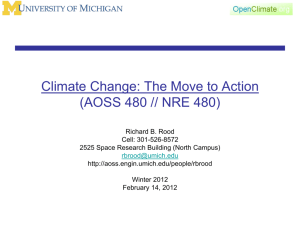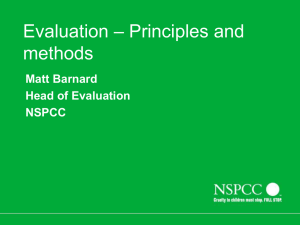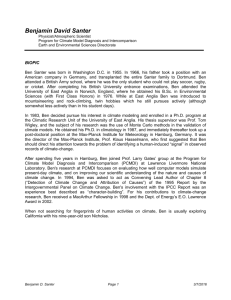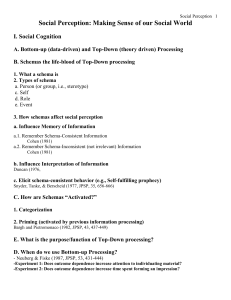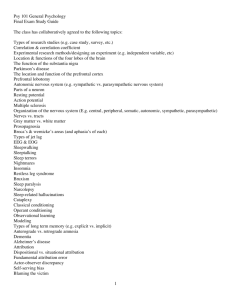AOSS_NRE_480_L11_Attribution_20150212
advertisement
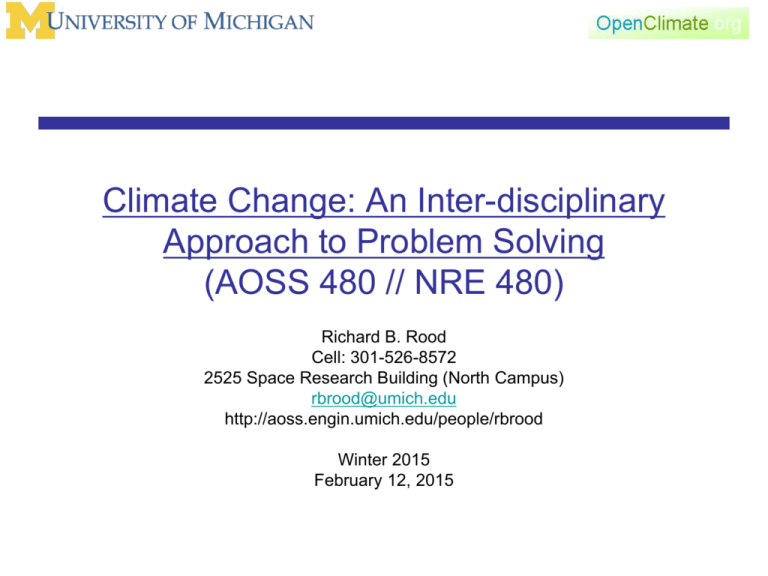
Climate Change: An Inter-disciplinary Approach to Problem Solving (AOSS 480 // NRE 480) Richard B. Rood Cell: 301-526-8572 2525 Space Research Building (North Campus) rbrood@umich.edu http://aoss.engin.umich.edu/people/rbrood Winter 2015 February 12, 2015 Class Information and News • Ctools site: AOSS_SNRE_480_001_W15 – Record of course • Rood’s Class MediaWiki Site – http://climateknowledge.org/classes/index.php/Climate_Change:_The_Move_to_Action • Next Tuesday, February 17th, Guest Lecturer – Shelie Miller, Scenario Planning • Tuesday, February 24th, Dr. Frank Behrendt Seminar "The German Energiewende - Roadmap to Germany's Energy System 2050” Tuesday, February 24, 2015, 10:00 AM to 11:30 AM, Ross School of Business, Room R1210, Resources and Recommended Reading • Hegerl_Santer_Fingerprint_JClim_1996 • Santer_Attribution_Fingerprint_Nature_19 96 • Throughout the presentation Outline: Class 11, Winter 2015 • Attribution – Event attribution – Fingerprinting – Joint Attribution (end-to-end method) • Rosenzweig et al., Nature, 2008 • Projects • East Coast Blizzard Discussion Event Attribution • Barriopedro et al., Russian Heat Wave, Science, 2011 • Dole et al., Russian Heat Wave, GRL, 2011 • Rahmstorf, Increase of Extreme Events, PNAS, 2011 • Peterson_Stott_Attribution_2011_Extremes_ BAMS_2011 • Shearer and Rood, Earthzine, 2011 • Hoerling, NOAA Brochure Attribution Signal to Noise From Leeds X-ray Imaging Signal to Noise (perhaps more like climate) From social research methods .net Signal to Noise (another example) Noise Signal Signal / Noise Ratio From astronomy and astrophysics .org Some signal to noise issues • We have many sources of variability – Sun, volcanoes, etc. – El Niño, La Niña, etc. – Ice ages, Little Ice Age, Warm Periods, etc. – Land use changes, natural carbon dioxide variability, etc. – How do we detect a trend in temperature and attribute it to human released carbon dioxide? Attribution • The physical climate and ecological observations in the previous are consistent with the planet is warming. • How do we decide that this is consistent with human-induced warming? Fingerprinting • Barnett_Santer_Ocean_Heat_Attribution_ Science_2005 • Santer_Attribution_Fingerprint_Nature_19 96 • Hegerl_Santer_Fingerprint_JClim_1996 Natural mechanisms influence climate Natural mechanisms • Changes in the Sun • Changes in the amount of volcanic dust in the atmosphere • Internal variability of the coupled atmosphere and ocean Thanks to Ben Santer for Content Thanks to Ben Santer for Content! Human factors also influence climate Non-natural mechanisms • Changes in atmospheric concentrations of greenhouse gases • Changes in aerosol particles from burning fossil fuels and biomass • Changes in the reflectivity (albedo) of the Earth’s surface Smoke from fires in Guatemala and Mexico (May 14, 1998) Recent changes in carbon dioxide are largely human-induced Carbon dioxide is the most important greenhouse gas produced by human activities Atmospheric CO2 has increased from a preindustrial value of about 280 parts per million (ppm) to 379 390 400 ppm in 2005 2010 2014 The atmospheric concentration of CO2 in 2005 2010 2014 exceeds by far the natural range (180 to 300 ppm) over the last 650,000 years Fossil fuel use is the primary source of the increased concentration of CO2 since the preindustrial period Thanks to Ben Santer for Content Source: IPCC AR4 (2007) Thanks to Ben Santer for Content Multiple lines of evidence on which “discernible human influence” conclusions are based 1. “Basic physics” evidence – Physical understanding of the climate system and the heat-trapping properties of greenhouse gases 2. Circumstantial evidence – Qualitative agreement between observed climate changes and model predictions of human-caused climate changes (warming of oceans, land surface, and troposphere, stratospheric cooling, water vapor increases, etc.) 3. Paleoclimate evidence – Temperature reconstructions enable us to place the warming of the 20th century in a longer-term context 4. Fingerprint evidence – Rigorous statistical comparisons between modeled and observed patterns of climate change Average surface temperature change (°C) Models can perform the “control experiment” that we can’t do in the real world Meehl et al., J. Climate (2004) What is “climate fingerprinting”? • Strategy: Search for a computer model-predicted pattern of climate change (the “fingerprint”) in observed climate records • Assumption: Each factor that influences climate has a different characteristic signature in climate records • Method: • Advantage: Fingerprinting allows researchers to make rigorous tests of competing hypotheses regarding the causes of recent climate change Standard signal processing techniques Thanks to Ben Santer for Content IPCC Temperature Observations Note: It gets smoother away from the surface. Different factors that influence climate have different “fingerprints” 10 24 20 50 20 10 0 16 10 0 16 20 0 12 20 0 12 8 50 0 70 0 10 00 90 N 4 60 N - 1 .2 Pressure (hPa) 30 N -1 10 Eq - 0 .6 - 0 .8 - 0 .2 30 S 0. 2 - 0 .4 0 60 S 0. 6 0. 4 90 S 1 0. 8 50 10 0 20 0 30 0 60 N 30 N -1 - 1 .2 - 0 .6 - 0 .8 Eq - 0 .2 - 0 .4 30 S 0. 2 0 60 S 0. 6 0. 4 Pressure (hPa) - 0 .4 30 S 0. 2 0 60 S 0. 6 0. 4 0. 8 1. 2 28 24 20 16 12 20 0 12 30 0 8 50 0 70 0 10 0 0 90 N 4 60 N -1 - 1 .2 28 30 N Eq - 0 .6 - 0 .8 - 0 .2 30 S 0. 2 - 0 .4 0 60 S 0. 6 0. 4 90 S 1 0. 8 1. 2 28 24 25 50 20 50 20 10 0 16 10 0 16 20 0 12 20 0 12 8 30 0 30 0 50 0 70 0 10 00 90 N 4 60 N -1 - 1 .2 30 N - 0 .6 - 0 .8 Eq - 0 .2 - 0 .4 30 S 0. 2 0 60 S 0. 6 0. 4 90 S 24 8 50 0 70 0 10 00 90 N 4 60 N 1 0. 8 -1 1. 2 6. 1st five factors combined 90 S 1 25 10 1. 2 - 0 .8 Eq - 0 .2 10 0 90 S 25 Santer et al., CCSP, 2007 - 1 .2 30 N - 0 .6 16 1 0. 8 60 N -1 20 4 4. Ozone 4 50 8 2. Volcanoes 8 50 0 70 0 10 00 90 N 28 24 10 30 0 10 1. 2 25 50 0 70 0 10 0 0 90 N 5. Sulfate aerosol particles 24 50 30 0 3. Well-mixed greenhouse gases 28 25 Height (km) 25 Height (km) 1. Solar Pressure (hPa) 28 Height (km) 10 - 1 .2 30 N - 0 .6 - 0 .8 Eq - 0 .2 - 0 .4 30 S 0. 2 0 60 S 0. 6 0. 4 90 S 1 0. 8 1. 2 °C/centur y “Fingerprinting” with temperature changes in Earth’s atmosphere Model Changes: CO2 + Sulfate Aerosols + Stratospheric Ozone 18 100 14 200 10 300 Height (km) Pressure (hPa) 50 6 500 2 850 60N 45N 30N 15N 0 15S 30S 45S 60S Observed Changes 50 100 14 200 10 300 6 500 2 850 60N 45N 30N -1. 5 -1. 8 Santer et al., Nature (1996) Height (km) Pressure (hPa) 18 15N -0. 9 -1. 2 0 -0. 3 -0. 6 15S 0. 3 0 30S 45S 0. 9 0. 6 60S 1. 5 1. 2 1. 8 Temperature changes in oC Searching for fingerprints of human activities in the world’s oceans • Initial work by Syd Levitus and colleagues showed an increase in the heat content of the oceans over the second half of the 20th century (Levitus et al., 2001, Science) • Subsequent research by Tim Barnett and colleagues identified a human fingerprint in the observed ocean heat content changes (Barnett et al., 2001, Science) Thanks to Ben Santer for Content “Fingerprinting” in the ocean: Warming of the North Atlantic over 1955-99 Thanks to Ben Santer for Content Barnett et al., Science (2005) “Fingerprinting” in the ocean: Warming of the world’s oceans over 1955-99 Thanks to Ben Santer for Content Barnett et al., Science (2005) Fingerprint detection explained pictorially…. Thanks to Ben Santer for Content Time-varying observed patterns MO D E L : P C M E O F : 1 E X P T :control B 0 0 4 . 1 0 - c n t r l Erun V : 27.40% N T : 3 0 0 MO N T H S Time-varying patterns D i m e n s 2i o9 n/ 0l e3s/ 0s 4 1 6 : 3 2 : 2 6 MO D E L : P C M E O F : 1 E X P T : B 0 0 4 . 1 0 - c n t r l E V : 2 7 . 4 0 % N T : 3 0 0 MO N T H S D i m e n s 2i o9 n/ 0l e3s/ 0s 4 1 6 : 3 2 : 2 6 E X P T : B 0 0 4 . 1 0 - c n t r l E V : 2 7 . 4 0 % N T : 3 0 0 MO N T H S D i m e n s 2i o9 n/ 0l e3s/ 0s 4 1 6 : 3 2 : 2 6 MO D E L : P C M E O F : 1 E X P T : B 0 0 4 . 1 0 - c n t r l E V : 2 7 . 4 0 % N T : 3 0 0 MO N T H S D i m e n s 2i o9 n/ 0l e3s/ 0s 4 1 6 : 3 2 : 2 6 MO D E L : P C M E O F : 1 E X P T : B 0 0 4 . 1 0 - c n t r l E V : 2 7 . 4 0 % N T : 3 0 0 MO N T H S D i m e n s 2i o9 n/ 0l e3s/ 0s 4 1 6 : 3 2 : 2 6 MO D E L : P C M E O F : 1 t=1 t=2 t=3 t=4 t=n -1 -0 . 6 - 1- 0 . 8 -1 . 2 -0 . 2 - 0 .-60 . 4 - 1- 0 . 8 -1 . 2 - 0 .-60 . 4 - 1- 0 . 8 -1 . 2 -1 . 2 0.6 0 . 20 . 4 - 0 . 20 - 0 .-60 . 4 - 1- 0 . 8 -1 . 2 0.2 - 0 . 20 -0 . 8 0 . 20 . 4 Projection onto model fingerprint 0 . 60 . 8 11.2 0 . 60 . 8 0 . 20 . 4 0 Model fingerprint -1 . 5 11.2 0 . 20 . 4 - 0 . 20 -0 . 4 1 0 . 60 . 8 - 0 . 20 - 0 .-60 . 4 t=1 t=2 t=3 t=4 t=n -1 . 2 5 0 . 60 . 8 0.4 0.8 -1 . 5 1.2 Signal and noise time series 1 . 215. 5 0 . 7 51 0 . 205. 5 - 0 . 2 05 -0 . 5 1.25 0 . 7 51 0 . 205. 5 - 0 . 2 05 - 0 . 7- 05. 5 -1 0.75 0 . 205. 5 - 0 . 2 05 - 0 . 7- 05. 5 - 1 . 2 -51 -1 . 5 0.25 - 0 . 2 05 - 0 . 7- 05. 5 - 1 . 2 -51 -1 . 5 11.2 -0 . 2 5 - 0 . 7- 05. 5 - 1 . 2 -51 -1 . 5 11.2 -0 . 7 5 - 1 . 2 -51 0 . 205. 5 0 1 . 215. 5 0 . 7 51 1 . 215. 5 0 . 7 51 0.5 1 . 215. 5 1 .5 Projection 1onto model fingerprint Signal-to-noise ratios -1 -1 . 2 -0 . 6 -0 . 8 -0 . 2 -0 . 4 0.2 0 0.6 0.4 1 0.8 1.2 Human-caused fingerprints have been identified in many different aspects of the climate system Thanks to Ben Santer for Content Surface specific humidity Water vapor over oceans Tropospheric temperatures -0 . 5 -0 . 6 Ocean temperatures -0 . 3 -0 . 4 -0 . 1 -0 . 2 0.1 0 0.3 0.2 Stratospheric temperatures 0.5 0.4 -1 -0 . 6 -0 . 2 Tropopause height 0.6 -1 . 2 -0 . 8 -0 . 4 0.2 0 0.6 0.4 Sea-level pressure Atmospheric temperature 50 18 100 14 200 Zonal-mean rainfall Near-surface temperature 10 300 6 500 2 850 60N 45N 30N -1. 5 -1. 8 15N -0. 9 -1. 2 0 -0. 3 -0. 6 15S 0. 3 0 30S 45S 0. 9 0. 6 Continental runoff 60S 1. 5 1. 2 1. 8 1 0.8 1.2 Key results of IPCC AR4: We are now able to identify human influences on climate at continental scales Continental warming likely shows a significant anthropogenic contribution over the past 50 years Thanks to Ben Santer for Content Joint Attribution • Rosenzweig et al., Nature, 2008 Summary from Rosenzweig et al., Nature, 2008 • • • • • shrinking glaciers in every continent melting permafrost shifts in the spring peak of river discharge associated with earlier snowmelt lake and river warming with effects on thermal stratification, chemistry and freshwater organisms increases in coastal erosion • • shifts in spring events (for example, leaf unfolding, blooming date, migration and time of reproduction), species distributions and community structure demonstrated changes in marineecosystem functioning and productivity, including shifts from cold-adapted to warm adapted communities, phenological changes and alterations in species interactions Joint attribution • What would you do to evaluate the theory and predictions of global warming? – Surface of planet will warm – Sea level will rise – Weather will change • Think about • • • • Measurements Feedbacks Correlative behavior Impacts • Joint Attribution • Documented statistical analysis • Process-level understanding Joint attribution • Joint Attribution – Documented statistical analysis – Process-level understanding • Look to see for biological systems – Unlikely due entirely to natural variability – Consistent with estimated responses of physical or biological variables – Non consistent with alternative, plausible explanations • That are in regions where physical variables, esp. temperature, can also be attributed to climate change • Consist with behavior of models run with and without carbon dioxide increase Global distribution of changes sensitive to temperature IPCC Technical Summary WG2 Summary: Class 11, Winter 2015 • Attribution • Event attribution Summary: Class 11, Winter 2015 • Fingerprinting • Joint Attribution (end-to-end method) • Rosenzweig et al., Nature, 2008 Outline: Class 11, Winter 2015 • Attribution – Fingerprinting – Joint Attribution (end-to-end method) • Rosenzweig et al., Nature, 2008 – Event attribution • Projects • East Coast Blizzard Discussion
